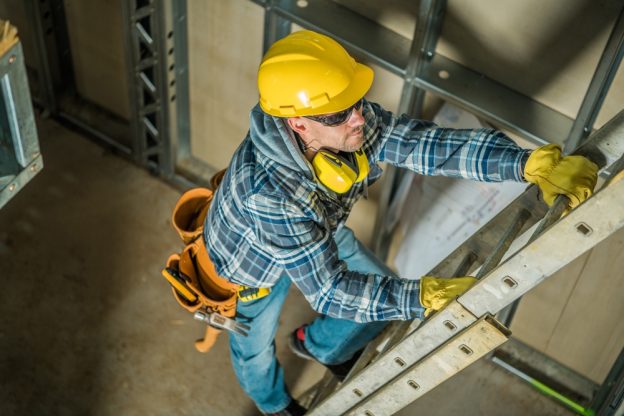Preparing for the California Contractor License Exam can feel overwhelming due to the sheer amount of material you need to cover. From contract law to job site safety, every detail matters. One area that the exam consistently touches upon is ladder safety. While ladders may seem like a basic tool that every construction professional already knows how to use, the state of California emphasizes very specific safety practices because ladder-related accidents remain one of the most common causes of construction site injuries. Understanding these rules isn’t just about passing the exam, it’s about protecting yourself, your crew, and your reputation on the job.
Why Ladder Safety Matters
Every contractor has a story about a co-worker who lost balance, skipped a step, or tried to reach “just a little further” from the top rung. These moments may seem minor, but ladders are involved in thousands of workplace injuries every year across the United States. According to OSHA, more than half of construction-related falls involve ladders. California regulators take this statistic seriously, which is why the Contractors State License Board (CSLB) expects license holders to demonstrate proficiency in safe ladder practices. The exam will not only test your knowledge of the rules but also whether you understand why those rules exist. In the real world, knowing the “why” often prevents costly accidents.
Choosing and Inspecting the Right Ladder
The first step in ladder safety is choosing the right ladder for the job. It might sound obvious, but many accidents happen because someone tried to “make do” with whatever ladder was closest. In the exam and on the job, you’ll need to recognize when an extension ladder, step ladder, or platform ladder is most appropriate. The height of the work area, the type of surface below, and the electrical hazards nearby all factor into that decision.
Before setting foot on a ladder, contractors are expected to inspect it. Look for cracks in wooden ladders, bent rungs in aluminum ladders, or missing safety feet. Even something as simple as dirt or grease on a rung can create a slipping hazard. The exam will emphasize that damaged ladders must never be used, no matter how minor the defect appears. Instead, they should be tagged “Do Not Use” and removed from the site until repaired or replaced.
Proper Setup and Placement
Once the correct ladder is chosen, the next critical topic is setup. Most exam questions refer to the “4-to-1 rule” for extension ladders: for every four feet of ladder height, the base should be placed one foot away from the wall or support. This ensures stability and prevents the ladder from tipping backward.
Surface conditions also matter. Ladders should never be placed on loose gravel, slick surfaces, or unstable ground without securing the base. In many construction sites, you’ll need to use ladder levelers or place solid boards beneath the feet to create a stable surface. Additionally, ladders must always be positioned at a safe angle and should never be leaned against an unstable object such as scaffolding or stacked materials.
In California, contractors are taught that ladders used to access elevated work areas must extend at least three feet above the landing point. This provides safe handholds when stepping off or onto the ladder. Forgetting this rule can result in dangerous missteps, especially when carrying tools or materials.
Safe Practices While Climbing and Working
Knowing how to set up a ladder is only part of the equation. Most accidents occur once someone is actually climbing or working. A key principle tested on the exam is the “three points of contact” rule. This means a worker should always maintain two hands and one foot, or two feet and one hand, in contact with the ladder. Carrying heavy materials while climbing is prohibited; instead, tools should be secured with belts, lifts, or ropes so that both hands remain free for climbing.
Another exam highlight is the prohibition against standing on the top cap or top step of a step ladder. It’s easy to see why, those surfaces aren’t designed to bear weight, making them highly unstable. Contractors are also expected to understand the importance of keeping their belt buckle inside the ladder’s rails. Overreaching is one of the leading causes of ladder falls, especially when workers try to avoid climbing down and repositioning.
A practical example that comes up often in safety training involves painting a high wall. A painter might be tempted to lean far to the side to cover just a bit more area. The correct answer, both on the exam and in the field, is to climb down, move the ladder a few feet, and then resume work safely.
Embedding Safety into Your Contractor Mindset
As you prepare for your California Contractor License Exam, treat ladder safety as a reflection of your professionalism. Clients, crew members, and inspectors will all judge the quality of your operation based not only on your craftsmanship but also on how safely you run your job sites. Being careless with ladders can erode trust quickly and lead to fines, delays, or worse, serious injuries.
Ultimately, the exam questions on ladder safety are designed to verify that you, as a licensed contractor, will prioritize prevention. If you can demonstrate that you understand how to choose, set up, and work from a ladder correctly, you’ll not only earn points on the test but also set the foundation for a safer career.
Conclusion
Ladder safety may feel like a simple subject compared to contract law, estimating, or labor compliance, but don’t underestimate its importance. The rules you’ll study for the California Contractor License Exam mirror the real-world practices that prevent accidents and keep projects running smoothly. By taking the time to master these basics, using the 4-to-1 rule, maintaining three points of contact, choosing the right ladder, and respecting the limits of the equipment, you’re investing in both exam success and a safer, more professional contracting career.
